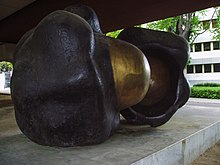Draft:El Paso (Group)

El Paso is a collective of artists founded in February 1957 in Madrid, being the most significant group in shaping and defining the Spanish post-war avant-garde.
The El Paso Group played a fundamental role in the process of normalizing a disoriented and scattered avant-garde since the end of the Civil War. It holds a unique significance due to the diverse backgrounds of its members, their artistic coherence despite the strong individuality of each one, and their committed and radical ideology.
History
Members of the collective
At the time of the manifesto's signing and during their initial exhibitions as a collective, El Paso's members included painters Rafael Canogar, Luis Feito, Juana Francés, Manolo Millares, Manuel Rivera, Antonio Suárez, Antonio Saura, and sculptor Pablo Serrano. Alongside these artists, art critics José Ayllón and Manolo Conde were part of the group. In 1958, artists Martín Chirino and Manuel Viola joined the collective. Additionally, architect Antonio Fernández Alba was also included.
Manolo Millares was born in Las Palmas de Gran Canaria, Antonio Saura in Huesca, Rafael Canogar in Toledo, Pablo Serrano in Crivillén (Teruel), Manuel Rivera in Granada, Antonio Suárez in Gijón (Asturias), Juana Francés in Alicante, Manuel Viola in Zaragoza, and the art critic José Ayllón in Tarragona. Only Luis Feito and Manolo Conde were originally from Madrid. This convergence mirrors a parallelism with the diverse origins and their encounter in Madrid, similar to the components of the so-called Generation of 1898.
Manifiesto
In March 1957, El Paso's manifesto was published, written by José Ayllón and featuring the group's symbol created by Antonio Saura, based on a work by Pablo Serrano. In April of the same year, the group's first exhibition was inaugurated at the Buchholz Bookstore-Gallery in Madrid.
A photograph of Manolo Millares, reproduced on several occasions, in which the painter is seen alongside a deteriorated sign that reads "PROHIBIDO EL PASO" (NO ENTRY), serves as a precise testimony of this contrarian attitude. In El Paso's manifesto (1957), it was stated: "We believe that our art will not be valid unless it contains a restlessness that coincides with the signs of the time, engaging in a passionate contact with the most innovative artistic currents. We are moving towards a revolutionary form of art - one that encompasses our dramatic tradition and our direct expression - historically responding to a universal activity."
The group came to an end in 1960 with an exhibition at the L'Attico Gallery in Rome.
Style and significance of the collective

The artists of El Paso began their artistic training in an environment where modernity was making its way in a precarious manner. In reality, it could be said that the art of the group members, like many other avant-garde artists of that time, did not correspond to the actual historical conditions of the country. Their activity was a labor that bridged a gap between an unstructured modernity and a radical avant-garde. To achieve this, similar to other painters who experienced the adventure of Informalism and built the poetics of Art autre, the knowledge of abstract avant-garde achievements was crucial. The avant-garde centered in Paris and the North American Abstract Expressionism served as the points of reference and contact with a new language that the artists of El Paso immediately assimilated and made their own. In this sense, they created an art where several components were part of a common denominator: the primacy of aggressive and intense expressiveness, the intentional reduction of color to minimal limits for its existence, and ultimately, the conviction in an artistic poetics of commitment.
One of the defining aspects of El Paso's artistic dimension was precisely their concern and critical attitude towards reality and their commitment to a historical situation. The avant-garde represented rebellion and rupture. The engagement with the current reality implied a shared attitude of fighting and negating the established norms that the members of El Paso identified with their artistic practice.
El Paso's artistic tradition has its roots in the expressive and radically aggressive painting of Goya's later works. The monochromatism and gesturality of Saura, the found and welded iron pieces influenced by the most radical Dadaism of Pablo Serrano, the material condensations of Feito, Suárez, and Juana Francés, the torn existential and pathetic anguish of Millares' burlap pieces, Rivera's metallic canvases, Viola's colorless nocturnes, Chirino's spirals, and Rafael Canogar's expressive and pulsating gestures all converge on an essential idea: the plastic and aggressive value of the Spanish tradition and its revitalization for a universal avant-garde. El Paso was an indispensable step in the affirmation of the avant-garde and the consolidation of Spain's artistic and historical modernity.
Bibliography
- NIETO ALCAIDE, Víctor. El Paso (1957 - 1960), en Enciclopedia Madrid S.XX
